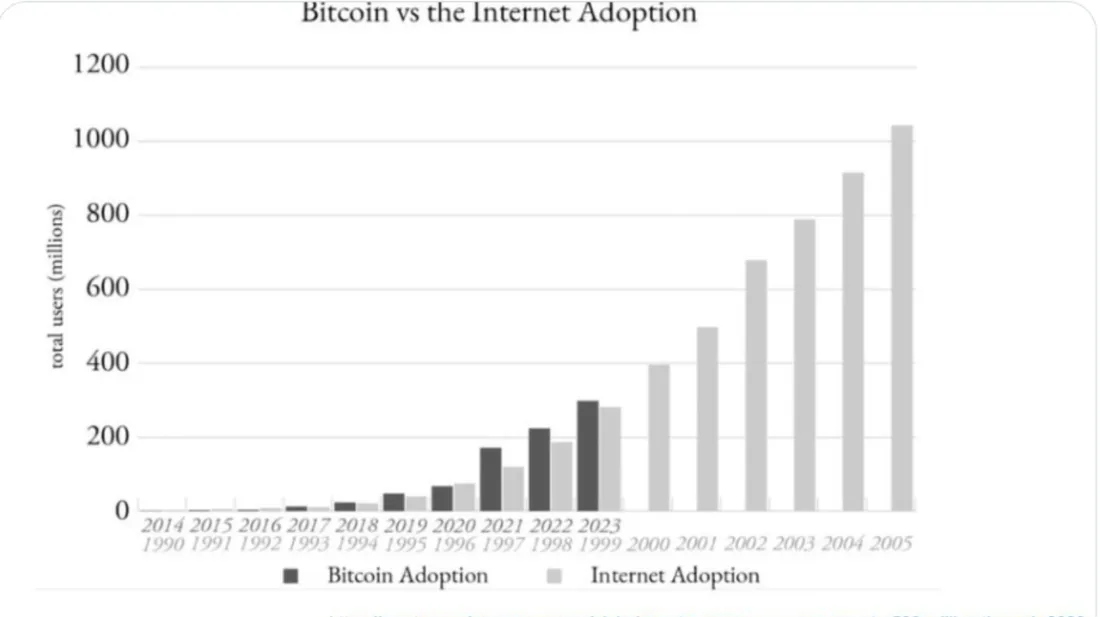EXPONENTIAL GROWTH
February 1, 2021
1BTC:$33543.770000
- Artist
- Fact Date
- Fact #
- undefined
- Printing Specifications
- Paper / Stock
- Page Size
It’s hard to imagine life without the internet, yet in 1997 it was a realm that most people had never experienced. In 2021, crypto economist Willy Woo noted that Bitcoin had the same amount of users as the web did in ‘97 but was growing at a faster rate. And we all know what happened next for the internet.
They say history doesn’t rhyme but it does repeat. And looking at Bitcoin’s adoption cycle, it’s hard not to draw parallels with that of the very technology that houses it – the internet. In the late 1990s, the internet was transitioning from a niche technology to a global phenomenon. By 1997, just 120 million people were online – about 2% of the world population.
By 2021 Bitcoin had amassed a comparable user base in just over a decade. Did this mean it was poised to experience the same exponential adoption curve that the internet underwent in the early aughts? While several observers drew analogies between Bitcoin and the early internet, credit with connecting the dots – and suggesting where they might lead next – goes to analyst Willy Woo.

The Evolution of Early Tech
While it was clear to those who discovered them in the early days that both the internet and Bitcoin were transformative tech, they weren’t especially easy to use. Their complexity, resulting in a suboptimal user experience, proved a significant barrier to adoption. In 1997, for instance, internet access was predominantly via dial-up modem over telephone lines, with connection speeds no faster than 56 kbps, while websites were mostly static HTML pages.
Nevertheless, by 1997 the internet had achieved a critical mass of users and a burst of innovation in terms of services, foreshadowing the exponential growth to come. It was still early days – the majority of the world had never been online – yet the trajectory was clearly upward. The dot-com boom was beginning and the transformative impact of the internet was becoming undeniable.
Bitcoin, meanwhile, launched in 2009 with no software wallet, no exchanges, and virtually no liquidity. All of these things improved over time – as did the speed and user experience of the internet – but this was to be an incremental, multi-year process as the core infrastructure was developed. By early 2021, Bitcoin had evolved from a cypherpunk experiment into a mainstream asset held by tens of millions but it was still a niche asset.
By Woo’s reckoning, Bitcoin in 2021 had about 135 million users, placing it in the same ballpark as the 120 million users the internet had in 1997. It had taken around a decade from the advent of the modern web for the internet to reach that number, while at the time of Woo’s comparison, Bitcoin had been around for 12 years.
Drawing patterns from the past is one thing of course. But could this backtested data be used to predict where Bitcoin would be headed next? Willy Woo gave it his best shot. According to his calculations, if Bitcoin’s user growth continued on the same trajectory, it would reach 1 billion users by 2025. As he pithily put it, “Internet 1997 = Bitcoin 2021; Internet 2005 = Bitcoin 2025.”

While the specific dates cited in the comparison don’t perfectly align, Woo’s thesis was broadly correct: Bitcoin’s number of holders and its price have both roughly quadrupled since his 2021 analysis. The early internet analogy remains valid.
- Artist
- XXXXX
- BTC On this day
- February 1, 2021
- Market Cap
- $624,468,642,448
- Hash Rate
- 138,089,292.973 TH/s
- Price Change (1M)
4%
- Price Change (3M)
139%
- Price Change (1Y)
259%
